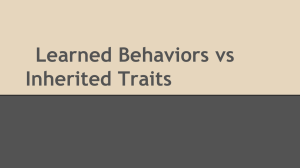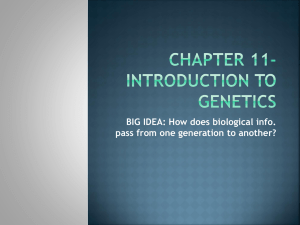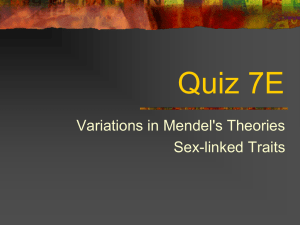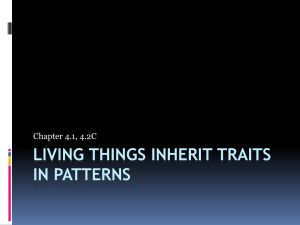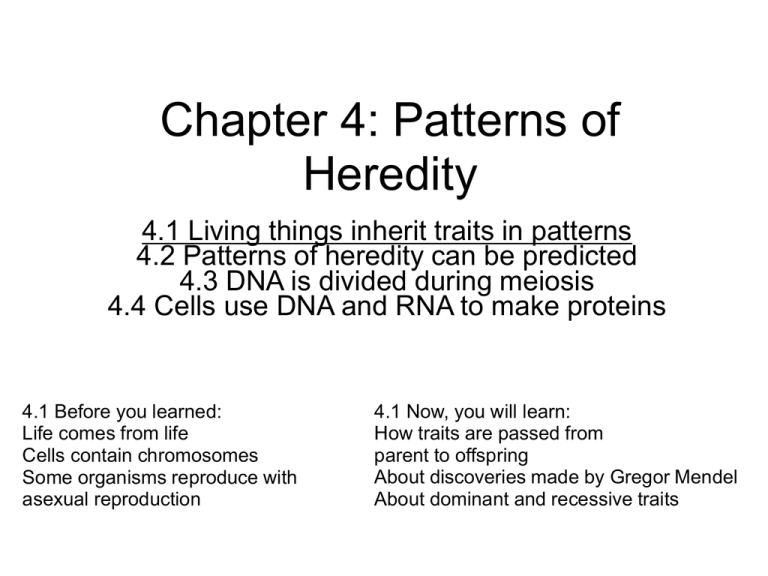
Chapter 4: Patterns of
Heredity
4.1 Living things inherit traits in patterns
4.2 Patterns of heredity can be predicted
4.3 DNA is divided during meiosis
4.4 Cells use DNA and RNA to make proteins
4.1 Before you learned:
Life comes from life
Cells contain chromosomes
Some organisms reproduce with
asexual reproduction
4.1 Now, you will learn:
How traits are passed from
parent to offspring
About discoveries made by Gregor Mendel
About dominant and recessive traits
Parents and offspring are similar
• Unique combination of characteristics: “Traits”
o
o
Inherited traits: Resemble parents: Traits such as hair color,
eye color, blood type
Acquired traits: developed through your life
Leaned behaviors: reading, writing, bike riding
• Examples that combine both inherited and acquired
traits?
• Musical skills, athletic skills
• Examples that are not learned but results from
interaction with the environment?
• Skin color
• How are inherited traits and acquired traits different?
• Inherited traits are not learned behaviors but are passed
from parent to offspring.
• Eye color is inherited.
• Acquired traits are learned
Genes are on chromosome pairs
• Inheritance happens through
o
Sexual reproduction: a cell containing genetic information from the
mother and a cell containing genetic information from the father
combine into a completely new cell, which becomes the offspring
• Genes are on chromosome pairs
Processes are coded for by genes: a unit of heredity that occupies
a specific location on a chromosome and code
o Heredity is the passing of genes from parents to offspring
o Genes code for the expression of traits
Traits are not inherited: the gene code for the trait is.
Many genes can code for one trait
o
Genes are on chromosome pairs
• Cells contain pairs of
chromosomes
• One chromosome of each pair
coming from each of two parents
• Homolog: chromosomes in a pair
o
Sites where specific genes are
located
Homologous
Chromosomes
Genes are on chromosome pairs
• Specific genes are located
– Whether or not a plant is tall is located at place A on a pair of
homologs
– Both homologs have the gene for height at site A, though the genes
may not be identical
• Variations: various forms of the same gene are called alleles
– The homolog from one parent might have an allele for regular height
at site A, the other parent has allele for short height at site A
Alleles
Two different forms of the same gene
• Humans have 23 pairs of chromosomes = 46 chromosomes
• Numbered 1 through 22; 23rd pair = sex chromosomes
• Sex Chromosomes: X and Y; Female: XX ; Male = XY
Gregor Mendel
July 22, 1822 – January 6, 1884
• Trained in science and
math
• A monk
• Began his study of the
inheritance of traits by
studying pea plants
• Traits:
• Plant height, flower and
pod position, seed shape,
seed color, pod shape, pod
color, flower shape
• Began with true breeding
plants to isolate traits (ones
that will always produce
offspring with a particular
trait when allowed to selfpollinate
Mendel: Inheritance
• Book’s example:
• 1) Mendel began with two true breeding
plants: one with regular and one with short
heights
• Deliberately paired as parents one plant
from each set: first generation
• Results: all offspring were regular height,
the short seemed to have disappeared
• 2) Let 1st generation plants self-pollinate:
2nd generation; ¾ were regular height, ¼
short
• Short height trait reappeared?!!
Mendel:
• Suggested each plant must have two “factors”
for each possible trait: one from each parent
• Some traits could be masked unless both the
plant’s factors were for it…such as dwarf
height
• How many factors or genes does each plant
have for each possible trait?
• Two
Alleles interact to produce traits
• Mendels’ plants were single genes, each of which
were on a different chromosome
– Most traits are controlled by many genes
• Phenotype: actual characteristics that can be
observed – eye color, height, feet size, eyelid fold
• Genotype: genes an organism has.
Dominant and Recessive Alleles
• Eyefolds and no-eyefolds…
– a dominant allele is one that is expressed in the
phenotype even if only one copy is present in the
genotype – even if the other allele is an alternative
form
– A recessive allele is one that is expressed in the
phenotype only when two copies of it are present
on the homologs
The Human Genome Project - video
• What were some of the strange and
unexpected things that scientists discovered
when they analyzed the human genome?
• Why do scientists compare the DNA of
bananas, worms, fruit flies, and humans?
How can this information be helpful
• Scientists have likened the human genome to
a parts list. Explain what they mean. Can you
think of another analogy?



